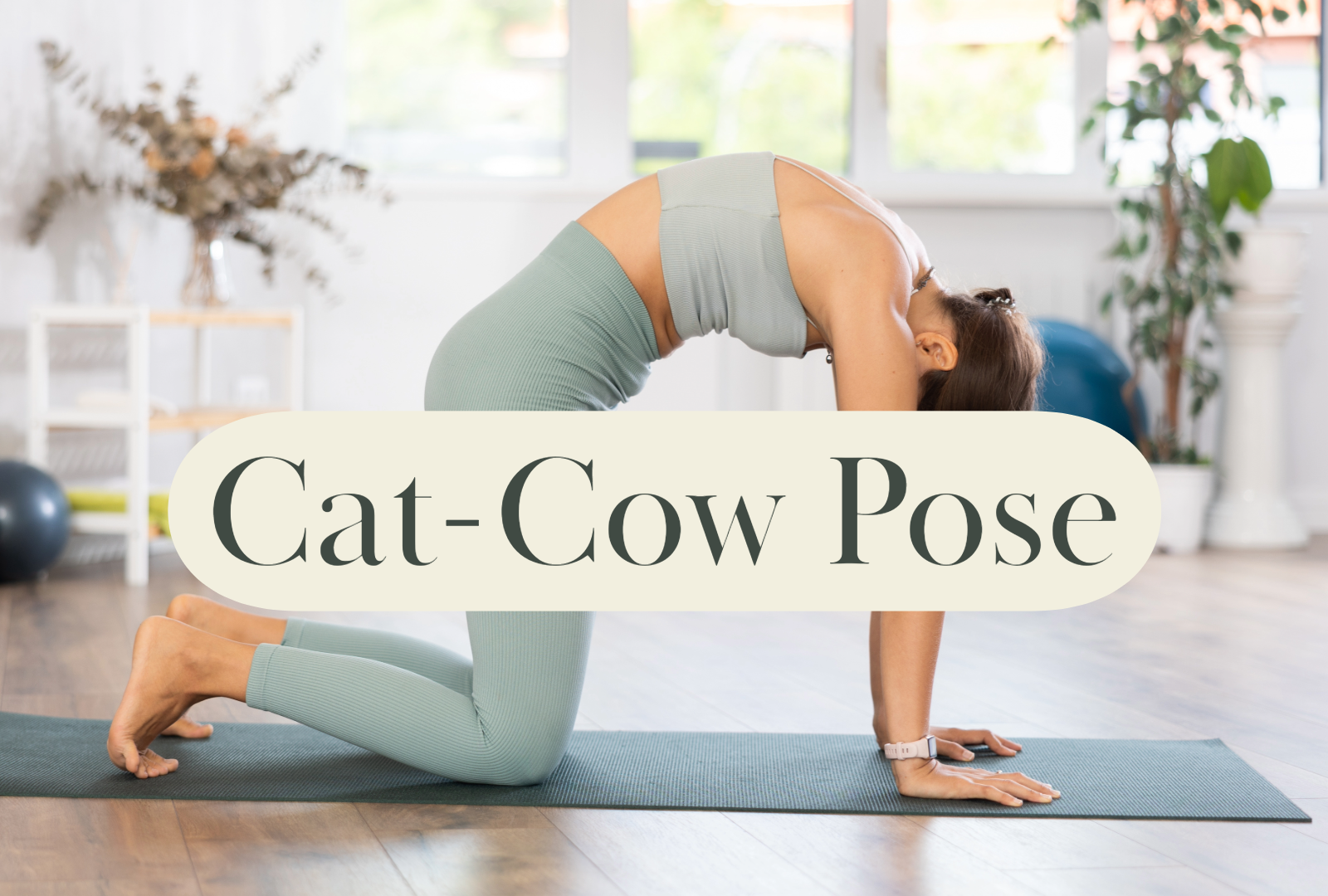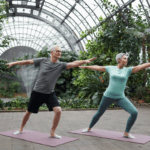Coming Soon: E-book about Kundalini Yoga - Sign up here to be among the first to get it!
Sanskrit: Matsyasana
Type: Prone Pose, Kneeling Pose
Chakra Involved: Solar Plexus (Manipura Chakra), Sacral Chakra (Swadisthana Chakra), Root Chakra (Muladhara Chakra)


The Cat-Cow pose, a combination of Marjaryasana (Cat Pose) and Bitilasana (Cow Pose), is a gentle flow between two poses that warms the body and brings flexibility to the spine. Practiced together, they help to stretch the neck, shoulders, and torso, while also stimulating the abdominal organs and promoting a healthy spinal fluid flow. This sequence is often recommended for easing back pain and is a great way to begin a yoga practice, offering both a gentle stretch and a method for calming the mind through focused breathing.
Starting Position
Begin on your hands and knees in a tabletop position. Ensure your knees are set directly below your hips and your wrists, elbows, and shoulders are in line and perpendicular to the floor. Center your head in a neutral position, eyes looking at the floor.
Step-by-step Instruction
Moving into Cow Pose (Bitilasana)
- Inhale: As you inhale, lower your belly towards the mat, lift your chin and chest, and gaze up toward the ceiling.
- Shoulder Blades: Draw your shoulder blades back and down, away from your ears, to open up your chest.
- Hips: Push your hips upward, enhancing the curve of your lower back.
Transitioning to Cat Pose (Marjaryasana)
- Exhale: Begin your exhale, and from Cow Pose, gently transition into Cat Pose by rounding your spine outward, pushing the middle of your back toward the ceiling.
- Chin to Chest: Bring your chin towards your chest, looking towards your navel, and drawing your belly button in towards your spine.
- Release the Shoulders: Allow your shoulders and neck to relax, creating space between each vertebra.
Flow Between Poses
- Continue to flow smoothly between Cow Pose on the inhale and Cat Pose on the exhale, synchronizing your movements with your breath. Perform this sequence for 1-2 minutes or as long as it feels comfortable.
To Release the Pose
- To come out of the Cat-Cow stretch, slowly return to a neutral tabletop position on an exhale. Rest in Balasana (Child’s Pose) by sitting back on your heels, stretching your arms out in front of you, and resting your forehead on the floor.
Teacher’s Tip
- Focus on the Spine: Encourage students to focus on the movement of their spine throughout the poses. Each vertebra should move sequentially, like a wave.
- Breath Coordination: Emphasize the importance of synchronizing the breath with movement, inhaling as the spine dips in Cow Pose and exhaling as it arches in Cat Pose. This enhances the meditative aspect of the sequence and increases spinal flexibility.
- Gentle Movements: Remind students that the movements should be gentle and controlled, without straining the neck or back. Encourage them to explore the full range of motion within their comfort zone.
- Modifications: For students with wrist discomfort, suggest using fists or forearms on the ground to reduce pressure on the wrists.
Cat-Cow is a simple yet profoundly beneficial sequence that can be incorporated into daily practice for improving flexibility, relieving stress, and maintaining spinal health.
Variations of Cat-Cow Pose (Marjaryasana-Bitilasana)
The Cat-Cow stretch is versatile, with several variations to accommodate different levels of flexibility, comfort, and the specific needs of practitioners. Here are some common variations along with instructions for each:
1. Balanced Cat-Cow
- Instructions: While performing the Cat-Cow stretch, lift your opposite arm and leg with each transition. Extend your right arm and left leg during Cow Pose, and draw them in towards your belly as you move into Cat Pose. Switch sides with each flow. This variation enhances balance and coordination.
2. Cat-Cow with Wrist Stretches
- Instructions: To incorporate a wrist stretch, turn your hands outward so your fingers point towards your knees during the Cat-Cow sequence. This variation helps relieve tension in the wrists and forearms, beneficial for those who use computers frequently.
3. Cat-Cow in a Seated Position
- Instructions: Sit on a chair with your feet flat on the ground. Place your hands on your knees. As you inhale, arch your back and look upwards for Cow Pose. On the exhale, round your spine and tuck your chin for Cat Pose. This seated variation is ideal for those who have difficulty getting onto the floor.
4. Cat-Cow with a Block
- Instructions: Place a yoga block between your thighs to engage your inner thighs and core more deeply during the sequence. Squeeze the block as you move through Cat and Cow poses. This addition helps to stabilize the pelvis and increase core engagement.
5. Sideways Cat-Cow (Lateral Flexion)
- Instructions: Add a side-to-side movement to the traditional Cat-Cow flow. As you inhale into Cow Pose, gently sway your hips to the right, stretching the left side of your body. As you exhale into Cat Pose, sway your hips to the left, stretching the right side. This variation introduces lateral flexion to the spine, enhancing flexibility and mobility.
6. Cat-Cow with Closed Eyes
- Instructions: Perform the traditional Cat-Cow sequence with your eyes closed. This variation encourages internal focus, mindfulness, and a deeper connection with bodily sensations, making the practice more meditative.
Implementation Tips
- Warm-Up: Ensure the body is warmed up before attempting variations that require more balance or flexibility.
- Listen to Your Body: Pay close attention to how each variation feels. Choose modifications that suit your current level of flexibility, strength, and comfort.
- Breath Coordination: Regardless of the variation, maintain a steady, rhythmic breath, syncing movements with inhales and exhales.
- Use Props: Don’t hesitate to use props like chairs, blocks, or mats to make the pose more accessible or challenging, depending on your needs.
Exploring these variations can keep the practice of Cat-Cow fresh and engaging, allowing practitioners to experience different aspects of this foundational sequence and its benefits.
FAQs About Cat-Cow Pose
The Cat-Cow Pose, a combination of Marjaryasana (Cat Pose) and Bitilasana (Cow Pose), is a gentle, flowing movement that offers numerous benefits:
- Spinal Flexibility: Enhances spinal flexibility and mobility by stretching the spine in both directions.
- Strengthens Muscles: Gently strengthens the abdominal muscles and spinal support muscles.
- Improves Posture: Regular practice can improve posture and balance.
- Stimulates Digestive Organs: The movement massages the organs in the abdomen, aiding digestion.
- Stress Relief: Helps relieve stress and calm the mind through gentle movement and focused breathing.
- Enhances Breathing: Encourages deep, mindful breathing, improving lung capacity.
- Prepares the Body: Acts as an excellent warm-up for the spine before engaging in more intense physical activity or yoga practices.
While Cat-Cow is a low-impact exercise suitable for most people, certain individuals should proceed with caution or avoid it:
- Severe Back Injury: Those with recent or severe back injuries should consult with a healthcare provider.
- Neck Injury: If you have a neck injury, keep the neck in line with the torso rather than dropping the head back or tucking the chin too much.
- Pregnancy: Pregnant women, especially in the later stages, should practice with caution and potentially modify the pose to accommodate their changing bodies.
The Cat-Cow Pose can be performed as many times as comfortable, but a general guideline for a balanced practice is to repeat the sequence 10-20 times. You can adjust the number of repetitions based on your comfort level, the intention of your practice, and how your body feels.
Yes, the Cat-Cow Pose is beneficial for the pelvic floor. The movement:
- Engages and Relaxes: The alternating action of arching and rounding the back helps to engage and then relax the pelvic floor muscles, improving their flexibility and strength.
- Increases Awareness: Practicing Cat-Cow can increase awareness of the pelvic floor muscles, which is beneficial for both strengthening and relaxation techniques.
- Supports Health: Regular engagement and relaxation of the pelvic floor muscles support urinary and reproductive health and can be particularly beneficial after childbirth or during menopause.
Overall, the Cat-Cow Pose is a gentle yet effective way to maintain spinal health, improve body awareness, and relieve stress, with the added benefit of engaging the pelvic floor muscles.




